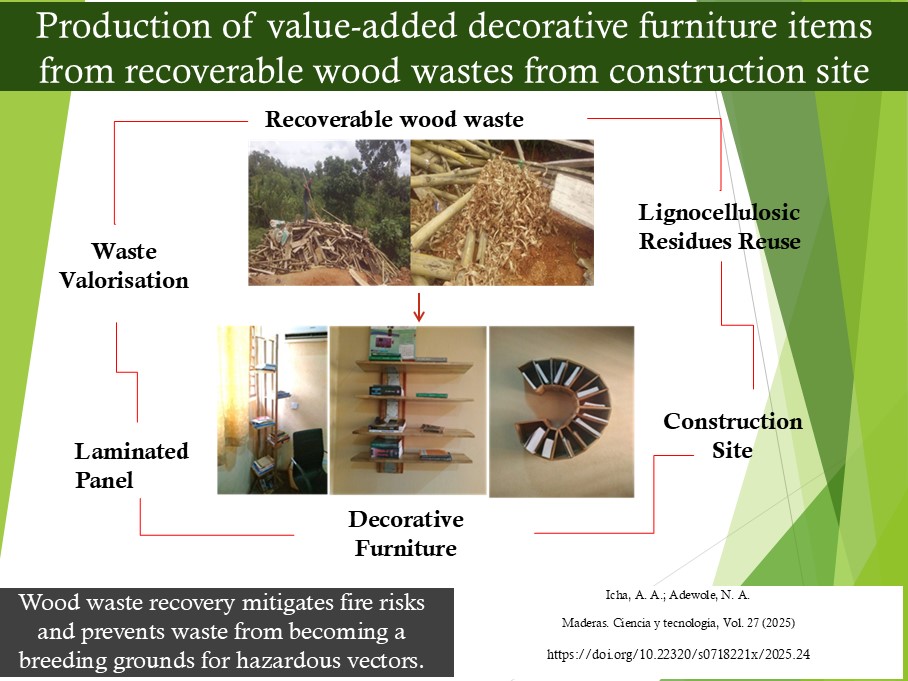Production of value-added decorative furniture items from recoverable wood wastes from construction site
DOI:
https://doi.org/10.22320/s0718221x/2025.24Keywords:
Bio-waste, construction site, decorative furniture, laminated panel, lignocellulosic residues, recoverable wood waste, waste valorisationAbstract
The cost of wood and non-wood lignocellulosic materials continues to escalate yet the demand keeps rising at the face of the climate change problem aggravated by unsustainable tree removal across the world. Lignocellulose waste is unavoidably generated during construction. The viability of producing decorative furniture items from recoverable wood wastes from a construction site was investigated. Ten construction sites were randomly chosen, for on-the-spot assessment to obtain information on characteristics of bio-wastes originating from construction sites. A 6-flat-storey building was selected for an in-depth study. Data were collected on the composition of bio-wastes, Retrievable volume, and exposure and deterioration status. Redundant fragments of wood wastes were retrieved and processed into glue-laminated panels, constituting intermediate raw material that was used for manufacturing three decorative furniture items. Although a wide range of bio-wastes was generated at the construction sites, wood, bamboo, and medium density fibreboard, wastes were generated more substantially and in decline order, respectively. Most of the bio-wastes had largely deteriorated, but about 60 % of the wood wastes can still be recovered for re-use. Re-using recovered wood for decorative furniture items may save as much as 73 % of the actual cost of wood needed for production, with a negligible increase in labour cost. Glued-laminated panels were used to manufacture shelves installed for office use. The study suggested that more values may be obtained from bio-waste reuse if retrieved without delay.
Downloads
References
Aderibigbe, Y.W.; Ataguba, O.C.; Sheyin, Y. 2017. Minimization of wastage of material on construction sites in Nigeria. International Journal of Advanced Academic Research Sciences, Technology & Engineering 3(9). e43. https://www.ijaar.org/articles/Volume3-Number9/Sciences-Technology-Engineering/ijaar-ste-v3n8-aug17-p10.pdf
Adewole, N.A.; Awe, O.M; Lucas, E.B. 2018. Investigating Lignocellulosic Wastes at Construction Sites in the University of Ibadan and Suggested Measures for Effective Management. In Proceedings of the 6th International Conference on Capacity Building for National Sustainable Development/Exhibition (CBNSD 2018) pp. 29-31. August 2018, Multimedia University Conference Centre, Nairobi, Kenya.
Adewole N.A.; Bello, K.O. 2013. Recycling of bamboo (Bambusa vulgaris Schrad) recovered from Scaffold into material for furniture production. Innovative Systems Design and Engineering 4(9): 73-79. https://www.iiste.org/Journals/index.php/ISDE/article/view/6256/6384
Adewole, N.A.; Olayiwola; H.O. 2011. Production of bamboo-lam from flat bamboo strips prepared from Bambusa vulgaris Schrad. In Proceedings of the Annual Nigeria Materials Congress (NIMACON 2011) held at Engineering Materials Development Institute (EMDI), KM 4 Ondo Rd. Akure, Ondo State, 21st - 24th November 2011. http://repository.ui.edu.ng/bitstream/123456789/1739/1/%282%29ui_inpro_adewole_pro-duction_2011.pdf
Adewole, N.A.; Icha, A.A. 2021. Preliminary evaluation of loss in physico-mechanical properties of woods recovered from construction site. African Journal of Agriculture, Technology and Environment 10(2): 1-7. http://ajate.com.ng/wp-content/uploads/2023/02/1_Adewole_AJATE_Vol-10-no-2.pdf
Agarwal, R.; Chaudhary, M.; Singh, J. 2015. Waste Management Initiatives in India for Human Well Being. European Scientific Journal 11:105-127. https://smartnet.niua.org/sites/default/files/resources/h16.pdf
Akinkurolere, O.O.; Aribisala, J.O.; Oke, O.L; Ogundipe, O.M. 2013. Construction waste recycling in sustainable engineering infrastructural development. International Journal of Development and Sustainability 2(2):1066-1074. https://isdsnet.com/ijds-v2n2-46.pdf
Alam, P.; Ahmade, K. 2013. Impact of Solid Waste on Health and the Environment. Special Issue of International Journal of Sustainable Development and Green Economics 2(1):2315-4721. http://punarv.in/wp-content/uploads/2022/04/Impact-of-Solid-Waste-on-Health-and-the-environment1.pdf
Ben-Iwo, J.; Manovic, V.; Longhurst, P. 2016. Biomass resources and biofuels potential for the production of transportation fuels in Nigeria. Renewable and Sustainable Energy Reviews 63:172-192 https://doi.org/10.1016/j.rser.2016.05.050
BS.1957. Methods of Testing Small Clear Specimens of Timber. BS 373. British Standards Institution: London WIA 2BS.
Eze, E.C.; Seghosime, R.; Eyong, O.P.; Loya, O.S.; 2017. Assessment of Materials Waste in the Construction Industry: A View of Construction Operatives, Tradesmen and Artisans in Nigeria. The International Journal of Engineering and Science 6(4):32-47. https://doi.org/10.9790/1813-0604013247
ESCAP. 2005. Types of Wastes. United Nations ESCAP. https://repository.unescap.org/bitstream/han-
dle/20.500.12870/2765/ESCAP-2006-PB-meeting-documents-2005.pdf?sequence=1 Date visited: 09/01/2019
Forest Products Laboratory. 2021. Wood handbook – wood as an engineering material. General Technical Report FPL-GTR-282. Madison, WI: U.S. Department of Agriculture, Forest Service, Forest Products Laboratory, pp. 195-221. https://research.fs.usda.gov/fpl/news/featured/wood-handbook
Grotowska, M.; Beer, P. 2023. Smart design upcycling of post-production display panels into new creative materials to support the sustainable development of a circular economy in the furniture industry. Annals of Warsaw University of Life Sciences-SGGW. Forestry and Wood Technology (122):36-46. https://bibliotekanauki.pl/articles/30146159.pdf
Lennon, M. 2005. Recycling Construction and Demolition Wastes: A Guide for Architects and Contractors. Commonwealth of Massachusetts, Department of Environmental Protection. 38p. https://archive.epa. gov/region1/healthcare/web/pdf/cdrecyclingguide.pdf
Mehta, P.K.; Monteiro, P.J.M. 2006. Concrete: Microstructure, Properties and Materials. Third Edition. p684. McGraw-Hill: New York, Chicago, San Francisco, Lisbon, London, Madrid. https://searchworks.stan-ford.edu/view/6345107
Popoola, L.T.; Yusuff, A.S.; Aderibigbe, T.A. 2019. Assessment of natural groundwater physico-chem-ical properties in major industrial and residential locations of Lagos metropolis. Applied Water Science 9(191):1-10. https://doi.org/10.1007/s13201-019-1073-y
Robinson, W.D. 1986. The Solid Waste Handbook: A Practical Guide. John Wiley and Sons: Chichester. https://archive.org/details/solidwastehandbo0000unse
Sun, Y.; Cheng, J. 2002. Hydrolysis of lignocellulosic materials for ethanol production: a review. Bioresource Technology 83(1):1-11 https://doi.org/10.1016/S0960-8524(01)00212-7
van Hees, M.; Oskam, I.; Bocken, N. 2024. Motives, drivers and barriers to urban upcycling: Insights from furniture upcycling in the Netherlands. Journal of Cleaner Production. e144485. https://doi.org/10.1016/j.jclepro.2024.144485
Wahab, A.B.; Lawal, A.F. 2011. An Evaluation of Waste Control Measures in Construction Industry in Nigeria. African Journal of Environmental Science and Technology 5(3): 246-254. https://www.ajol.info/in-dex.php/ajest/article/view/71933/60889
Wright, C.S.; Cameron, S.B.; Jeffrey, W.K. 2010. Estimating volume, biomass, and potential emissions of hand-piled fuels (805). US Department of Agriculture, Forest Service, Pacific Northwest Research Station. Or Gen. Tech. Rep. PNW-GTR-805. Portland. http://doi.org/10.2737/PNW-GTR-805

Downloads
Published
How to Cite
Issue
Section
License

This work is licensed under a Creative Commons Attribution 4.0 International License.
Los autores/as conservarán sus derechos de autor y garantizarán a la revista el derecho de primera publicación de su obra, el cuál estará simultáneamente sujeto a la Licencia de Reconocimiento de Creative Commons CC-BY que permite a terceros compartir la obra siempre que se indique su autor y su primera publicación esta revista.



































